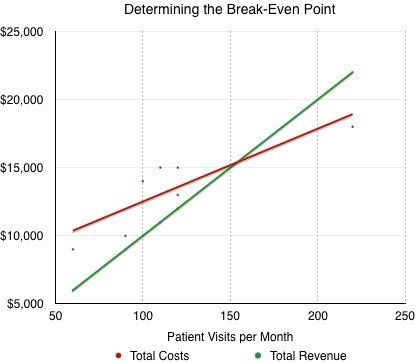Determine your break-even point
Knowing your break-even point will help you plan for the future.
©Evlakhov Valeriy/Shutterstock.com



All business owners should know their break-even point. If you don’t, then you’re likely shooting from the hip as you attempt to “manage” your business.
The break-even point is a simple concept. It’s the productivity point where the revenue earned equals the expenses incurred. Those expenses include both the fixed and variable costs. When productivity is above the break-even point, a profit is earned. When productivity is below it, a loss is incurred.
There are two ways you can look at the break-even point: the revenue needed or the productivity level needed. You might be asking yourself, “Why bother?”It might be a little challenging to arrive at your cost and revenue functions but calculating this will give you great insight into your practice’s financial health.
In a previous column, I wrote about understanding the different costs of doing business. We looked at how you can determine your fixed and variable costs using a graph. With your revenue calculation in hand, you can plot both your cost formula and your revenue formula. That graph allows you to determine your break-even point by identifying the point where the two lines intersect.

Shift your productivity levels to the left where the red line is above the green line, and you’re losing money. Move productivity to the right where the green line is above the red line, and you’re earning a profit.
Using this simple yet effective visual method, you can approximate your practice’s break-even point. In this example, it appears the break-even point is about 150 patient visits per month.
Not a fan of making graphs? No problem. The break-even point can also be calculated using simple algebra. All you need to determine your break-even point is your cost and revenue equations. Simply set the revenue and cost equations equal to each other and solve for the volume. The final equation looks like this:

The final number represents the number of patient visits you will need each month to break-even. See more patients, and you will be earning a profit. See fewer patients, and you’re in for a loss.
Determining your break-even point is the fastest way to learn if your charges or expected volume will cover the costs of your services. If they don’t, then you know where to focus your efforts. Here are four things to consider if you find yourself near the break-even point.
1. Raise your prices. Go back to all of your payers and renegotiate for higher rates. Identify your lowest-paying payers and negotiate for a rate that matches or is close to your highest-paying payers. Another fruitful exercise is to do some market research see if you are charging below the prevailing market rate, then negotiate to be on track with your peers.
2. Increase your volume. How well are you scheduling your day? Is your clinic at capacity, or do you have downtime? Look for ways to increase the patient traffic in your clinic. Start with existing patients. Do you send out regular reminders for preventive or follow-up appointments? Do you have extended hours at nights or on the weekend? Do you offer same-day appointments? If so, make sure your patients know about these convenient service offerings. If you’re not already accepting new patients, do so-and make sure to alert providers so they can update database of in-network providers. You might also consider marketing your practice, increasing your marketing efforts, or trying new marketing techniques to draw patients into your practice. Educational videos and social media are a great low-cost place to start.
3. Reduce your fixed costs. Fixed costs have a significant effect on your break-even point. Do what you can to drive down your fixed costs. Renegotiate your existing contracts with your vendors, such as your office lease or other medical services. Create a robust accounting system for accounts payable and accounts receivable to make sure you’re managing your bills properly, and the invoices you receive match what you are expecting to owe.
4. Reduce your variable costs. Look for ways to reduce your variable costs, too. This may mean staff reductions, outsourcing, cheaper alternatives or substitutes for goods or services, or switching vendors. Your variable costs won’t have as great an impact as the fixed costs on the break-even point, but it’s still important regularly review them to ensure they are in-line with market prices. If not, adjust accordingly so you can start saving.
Caring for your financial well-being is an important, yet often overlooked, aspect of practice management. You need to make sure you aren’t worried about your practice’s finances while seeing patients. If you are, then you’re not helping anyone, least of all your patients who depend on you for life-giving treatment and advice.
David J. Norris, MD, MBA, is a practicing anesthesiologist in Wichita, Kan. He is the author of The Financially Intelligent Physician: What They Didn’t Teach You in Medical Schooland a frequent speaker on physician finances. Read more about David at www.davidnorrismdmba.com.